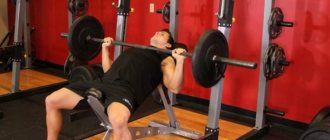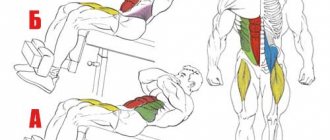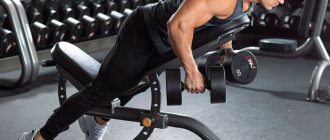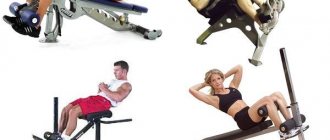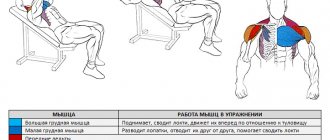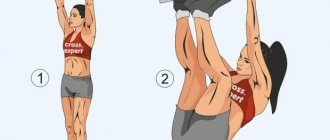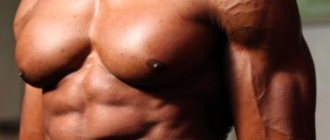Share VK Share FB Share OK
Guys usually devote Monday to chest training, so when entering the gym, it’s impossible not to notice the queue lined up at the bench presses. Everyone wants to get on the horizontal bench, not noticing the modestly standing inclined one - at an upward angle, and especially the lonely empty downward bench, which a rare athlete pays attention to.
Incline bench training (muscle atlas)
Bent over training involves different positions of the lower extremities relative to the head, due to which the load is redistributed. So, performing a barbell press with your head down, i.e. when the head is lower than the legs, the lower part of the chest muscles is loaded. The large muscle, as is known, consists of a lower and upper part. The first is called the “sternal head”, the second is called the “clavicular head”. They both perform arm adduction, i.e. pull the limbs towards the midline.
The head-down barbell press directs the load (almost all) to the sternal head, and training is most effective at an inclination of 20-45 degrees.
The following muscles also participate in the head-down barbell press: the anterior deltoids and triceps, which experience greater load when replacing the grip with a narrow one.
The anatomical atlas looks like this:
Bodybuilders use it if they need to thicken the lower edge of the pectorals and “cut” them, making them more expressive and separating them from the main body.
Equipment
Athletes who practice this type of bench press always work with a lot of weight. To do this, they use a bar and discs that form a barbell. As an additional means of protection, you can use gloves that provide better grip on the surface of the bar. Also, many athletes prefer to additionally protect themselves from lower back injury, so they wear an athletic belt.
In some cases, a soft support is placed on the chest, which will prevent the heavy barbell from putting too much pressure on the chest muscles. However, in this case, you will have to resort to the help of a belayer to help remove the stand and place the barbell on the rack.
Advantages of this barbell press option
The athlete receives the following benefits:
- volumetric development of the chest muscles is uniform in each segment, which is achieved thanks to the load at different angles;
- lifting the bust (important for women) and tightening the lower décolleté;
- increasing strength in the classic bench press;
- exiting the period of stagnation when performing a horizontal barbell press;
- muscle mass increases;
- activation of the lower pectorals increases and less activation of the auxiliary ones;
- targeted load – transition to the pectoralis major muscle from the anterior deltoids;
- unloading of the shoulders, reducing the risk of injury;
- relieves tension from the lower back muscles.
We recommend:
- Incline Bench Press: Correct Execution
- Barbell row to the chin: secrets and subtleties of execution
- All about the seated barbell press
Main advantages
By performing dumbbell (barbell) presses while lying upside down, you can get the following benefits:
- increase in strength indicators in the usual bench press;
- tightening the lower neckline, “pushing it out”, raising the lower part of the pectoral muscles (very good for women);
- effective fight against stagnation in the standard (horizontal) press, when the weight remains in one place for a long time;
- load on the auxiliary and lower pectoral muscles;
- optimal distribution of the load and its shifting to the necessary part of the muscle group - the pectoralis major muscle;
- reducing the load on the lower back;
- reducing the load on the shoulders, as well as reducing the risk of injury.
This list is enough to ensure that such an effective bench press is not left out of the training process.
Correct technique
Training, in which the head is lower than the feet, is difficult from a coordination point of view. The position of the bench adds complexity. This makes it important to learn the intricacies of the technique before starting training.
Preparatory step.
- Set the back of the bench to the lower position, setting the required angle.
- Then the bar is loaded with weight, placed under the apparatus, and the legs are secured to the support rollers.
- The bar is taken with a grip wider than shoulder width.
- Remove the rack and hold the projectile above the lower chest on your arms perpendicular to the floor.
This is the IP.
First step.
- After inhaling, begin to slowly pull the projectile down until it touches the lower part of your chest.
- After a second delay in this position, exhale and press the barbell up.
Second step. Do reps.
For a more detailed study of the technique, below is a picture version and the performance of a barbell press in dynamics:
Technical errors
Wrong trajectory
Some people manage to make this movement into a parody of the bench press. They press straight up at the highest point, pushing the barbell away from the body. This turns out to be a rather traumatic variation for the shoulders, which, as the weight increases, also becomes a cause of falls. Another trajectory error is placing the barbell sharply behind the head; this option is not acceptable because it contributes to unnatural overload of the cervical spine. The third trajectory error is the “nose press,” that is, performing the exercise at half the amplitude.
A hodgepodge of styles and exercises
Some athletes confuse this movement with the barbell overhead press due to technique. They do not press their forearms to the body, but do all the work by pushing the weight away from themselves and moving it behind the head. In this case, the elbows are spread to the sides, and the shoulders at the start are parallel to the floor. Everything would be fine if this particular initial position did not cause subacromial syndrome. Using this technique is fraught with joint pain.
Big ego
Huge weights lifted up look cool. But then treating inflammation of the ligaments and muscle tears is not at all as great. Working weights should be increased only when the movement technique allows them to be increased. Everything else is still superfluous.
Engaging your legs, back, and core
Some athletes, instead of bench presses, perform a half-push, a push-up, anything to push the weight with their legs. If you can’t squeeze the barbell smoothly with your hands, you should simply reduce the weight of the weight. It is not necessary to work with the help of the body and legs.
Heel-to-toe rolls
Many people find it difficult to hold weight without losing balance during exercise. Such people should try to carefully maintain their balance by placing their weight in the middle of the arch of the foot. If this doesn’t work out and all you can do is roll, you should switch to a seated press and simultaneously work on developing the muscles of your legs and core.
Excessive training volume
This is common for all beginners. It seems to them that the program is for hacks, and they train less than everyone else in the gym. So the person begins to perform all the approaches that, in principle, he can perform. The volume increases significantly, but the intensity stops growing. The athlete experiences pain in his ligaments and joints, he does not get stronger, and his training simply becomes another attempt to overcome himself. Over time, cumulative injuries appear, and the person refuses to exercise.
Lack of mobility in joints
Sometimes they write that movement cannot be performed only with arthrosis and osteochondrosis, but the problem is that a completely healthy person may be unable to make a movement of exactly this amplitude due to “office posture,” that is, weakness of the back muscles when the trapezius and pectoral muscles are overloaded. Over time, as your back strengthens, you will be able to lift weights overhead more effectively. Until this point, it is recommended to work with dumbbells.
The military press is a heavy compound exercise. But the norm for an amateur is to lift about half of his weight in this movement; there is no need to force things. If a person cannot lift more weight without pain, progress must be taken gradually, and be sure to actively engage in injury prevention.
The exercise should be included in your training on a regular basis, but it is better not to train your shoulders more than 2 times a week if you are a beginner, and try not to overload them even if you are an experienced athlete. It makes sense to perform either a heavy bench press or a heavy standing press, rather than constantly doing both heavy. Try to work efficiently, and you will always be able to train effectively.
Discovering the secrets of proper execution
Solving some of the secrets of the head-down barbell press will help you get the maximum effect from the training:
- in the upper position, squeeze your chest and hold for a couple of counts;
- beginners are recommended to perform the barbell press head down only with a belay partner or in a Smith machine;
- the projectile “walks” in a horizontal plane - do not allow it to “walk” or go far, touching the other area of the chest rather than the lower one;
- lower the projectile 2 times slower than you lift it;
- do not hit the barbell in the lower extreme position;
- use the full range of motion if possible: lift the apparatus, straightening your arms fully, and lower it, avoiding impacts;
- elbows constantly look to the sides - control their position during training;
- to reduce blood pressure in the head, as soon as the projectile passes the heaviest part of the trajectory, exhale powerfully;
- due to the specific position of the bench, blood pressure increases, so hypertensive patients are advised to refrain from performing barbell presses with their heads down.
Good to know
- You should always start your workouts with a warm-up; if you forget about it, the consequences can be the most unpredictable, from muscle pain to injury.
- When performing a bench press, you should not press your elbows too hard against your body, as the trajectory of movement changes and the risk of injury increases.
- You should get up from the board slowly; if you do it quickly and abruptly, athletes with a weak cardiovascular system may experience dizziness and, as a result, fainting.
- Squeezing a large weight with sudden jerks and at high speed is an ideal opportunity to injure ligaments and joints, and the effect of the exercise is significantly reduced.
- Inexperienced athletes need to learn how to work their back and shoulders correctly, otherwise no complex presses will help in achieving the desired result.
- You should avoid twisting your wrists: you need to evenly distribute the weight of the barbell on your palms, and when performing the exercise, your hands should work simultaneously and in the same plane.
- If it becomes necessary to place a towel or pad on the bench, then rigid fixation of these objects is necessary - any sliding during the bench press is unacceptable.
- It is necessary to regulate the weight of the apparatus: it can be maximum in one workout from the cycle, and the best result is obtained by an exercise with a weight ten percent lower than the maximum.
- If the gym does not have a bench for bench press lying with your head down, you can use an inclined bench to work out your abs; just set it at an angle of 30 degrees and you can start exercising.
Which option is more suitable for developing chest muscles?
A 2010 study by Wayne State College researchers found that training with the head lower than the legs is more beneficial for the pectoral muscles than training with the head higher than the limbs. The latter is recommended for athletes who are working on the development of the clavicular region. If the priority is the development of the sternal region, then perform a “lower” press.
Studies measuring electrical activity (EMG) of the two options under consideration have proven that both presses stimulate the upper chest equally, contrary to the popular belief that this is “produced” better by the upper chest press.
How the two exercises affect the lower chest is shown in the figure (right). The picture helps you understand that the “lower” press stimulates the fibers and has a better effect than the “upper” one.
Another study using electromyography was carried out by Todor Bompa (scientist and security official). It proved that the head-down barbell press directs the load (almost 100%) to the chest muscles without dissipating or wasting it. Consequently, the neuromuscular stimulation in this variant is high - twice as much as the horizontal bench press.
But, in addition to science, the biomechanics of movements, or rather the weight being squeezed, is important: the load increases with increasing weight.
Considering the head-down and horizontal barbell press, it is noted that in the first case, the working weight that the athlete is able to overcome is 10-15% more.
This happens for the following reasons:
- The “lower” bench press involves much more muscle fibers into the work, so the power force developed is also greater;
- also, a powerful force is developed due to a shift in the emphasis of the load on the latissimus dorsi muscles (from the triceps and deltoids), due to the special position occupied by the body, and the adduction (adduction) of the shoulder joints;
- The amplitude of movement during the “lower” press is smaller compared to the horizontal press, so it is easier to move the weight over a shorter distance.
Conclusion: Under certain conditions, the head down press is the best option for muscle mass and development of the lower pecs.
Video: Barbell head down press
Anatomy
The overhead press targets the strongest core of the pectoral muscles, but isolates it, so the weight should be selected with this factor in mind. In addition, since the athlete lies upside down, the exercise must be performed in the range of 12-15 repetitions, that is, with a weight at which energy is supplied through glycolysis and the formation of lactic acid. It is precisely because of the latter that there is a need to monitor breathing so carefully, since proper breathing facilitates the work of the liver. In addition, proper breathing will help reduce intracranial pressure.
From an anatomical point of view, the head down press is not the best exercise, so it should not be performed often, but only in specialized training programs. And beginners certainly shouldn’t perform this exercise in their first training programs. It should also be noted that in this exercise the shoulder joints are not in a very comfortable position, so it is better to move your elbows not to the sides, but to move them along the body as powerlifters do. To summarize, we can say that the exercise helps correct imbalances in breast development, but it should only be used by experienced athletes.
Other exercises
How to perform exercise
- To begin, place a flat bench (or preferably one with back support) underneath a smith machine. Position the barbell at a height so that when seated on the flat bench, the arms must be almost fully extended to reach the barbell.
- Once you have the correct height, sit slightly in behind the barbell so that there is an imaginary straight line from the tip of your nose to the barbell. Your feet should be stationary. Grab the barbell with the palms facing forward, unlock it and lift it up so that your arms are fully extended. This is the starting position.
- Slowly begin to lower the barbell until it is level with your chin while inhaling.
- Then lift the barbell back to the starting position using your shoulders while exhaling.
- Repeat for the recommended amount of repetitions.
What can be replaced
- .
Helps work the muscles of the arms and chest. The classic press is performed in a supine position. In the starting position, the projectile is located above the chest, while the arms should be extended. The exercise can also be done from a position where the barbell lies on its stops, from this position it is done upward and the projectile returns back to its racks. - In touch. This training consists of the fact that as soon as the bar touches the chest, the bench press is carried out immediately without unnecessary delays.
- Framed. This training is performed inside a power rack. In the starting position, the projectile must be on the limiters. The bar should be located at chest level. All repetitions are performed from a point located below. This type of training can be called quite safe, which can be done without a person who insures.
- On an incline bench. Gives you the opportunity to work from below and from above. The higher the head is, the greater the load on the upper chest and vice versa.
- Grip width. The grip is very important when it comes to work, because sometimes it determines which part of the body will be actively trained.
- this is an isolating exercise, yes, we emphasize once again, this is an isolating exercise that must be performed with moderate weight and in a large number of repetitions. Under no circumstances do it forcefully if you do not want to develop diseases of the cardiovascular system or high blood pressure! You need to be careful with this exercise, but you shouldn’t avoid it either. There are times when it is indispensable, but not for achieving hypertrophy of the pectoral muscles, but for adjusting the proportions and shape of the breast. The fact is that such an accentuated development of the lower part of the pectoral muscles helps to lift the chest up.
However, there is no point in performing a head press in order to hypertrophy the muscle fibers of the lower chest! The lower bundle of the pectoral muscles is already its strongest bundle, so it always receives most of the load during chest exercises. Actually, on the contrary, if you want to pump up your chest
proportional, then you should focus on its upper part, which is almost always underdeveloped. And only in exceptional cases, when for some reason a disproportion has formed, perform a special press to pump the lower chest.
Technique for performing dumbbell presses upside down
Inhale and rotate the dumbbells parallel to each other, then begin to press them up. Exhale with effort. At the top point, the dumbbells should touch smoothly and not bounce off each other. Do not straighten your arms completely: this will transfer the load to the triceps and this is dangerous for the elbow joints; keep your elbows slightly bent. As you inhale, lower the dumbbells down until they touch your shoulder or pectoral muscles. When lowering the dumbbells, your elbows look to the sides and down. After contact with the body, immediately inhale and press the dumbbells up.
- After completing the approach, drop the dumbbells and take 2-3 breaths and then stand up.
- Try performing a dumbbell press upside down with supination and pronation. Supination
is when the palms turn towards each other at the top point.
Pronation
is when the palms turn towards each other at the lowest point. - Take the weight less than 15-20% of the dumbbell horizontal press.
- Do not lift your lower back off the bench, this will put more stress on the pectoral muscles, but then take less weight on the dumbbells.
- To be on the safe side, ask an assistant to back you up; let him squat next to your head and help you squeeze the dumbbells by pushing under your elbows.

